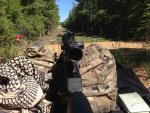The first time was when I shot at 1000yd, and it was in competition. I had been shooting to the limit of my previous range which was 300 yards. It was one of those once-in-a-lifetime calm days at 1000yd, and I couldn't stop asking myself, "Is it really just this simple?". Well that day it was, but it has never been since.
It was the second day on the line that gave me the Ah-Hah! I was eyeballs to eyeballs with the wind. Let me say that again, THE WIND!
That was the day that I finally, rightly, recognized that the wind is neither an ally nor an enemy, and that it is best considered as a tool. It is a fact of life, a constant companion, and one learns that one can either let it blow your round off target, or let it be a tool that you use to blow your round ONTO the target.
I found that in order to understand what the wind was doing, one needed to practice observing it while observing its effects. Once establishing a zero with sighters under the prevailing wind, keep shooting without further adjustment, observing the range for wind tells, and watching the fall of the shot on the target. X set of conditions renders X POI shift, and Y set of conditions renders Y POI shift.
Once you think that you can start making a prediction, modify your POA (still not adjusting sights) and see how close you come to POI Z under Z conditions. In essence you are aiming off the desired POI and letting the wind blow your round back onto the desired POI.
This was the beginning of my continuing improvement in LR shooting. A couple of years shooting F Open in a 1000yd F Class League (when it was active at Bodines in PA) solidified the lessons learned, and the wind was only the first one of them. But without the wind, the others are not going to get you anywhere near where you want/need to be.
And then; there is the dance...
Learning to shoot the wind is like learning to dance. In order to dance well, we need to find that dance partner and dance, dance, and yes, dance some more. Seek her out, grasp her with confidence, learn her every step, and meld yourself with her most intricate motions.
So let it be with the wind as well. Seek out the wind, glory in her presence, make her your partner in all her guises.
Fear it not, resent it not. It's there to teach and guide you, to be your better half.
Embrace the wind.
Greg


